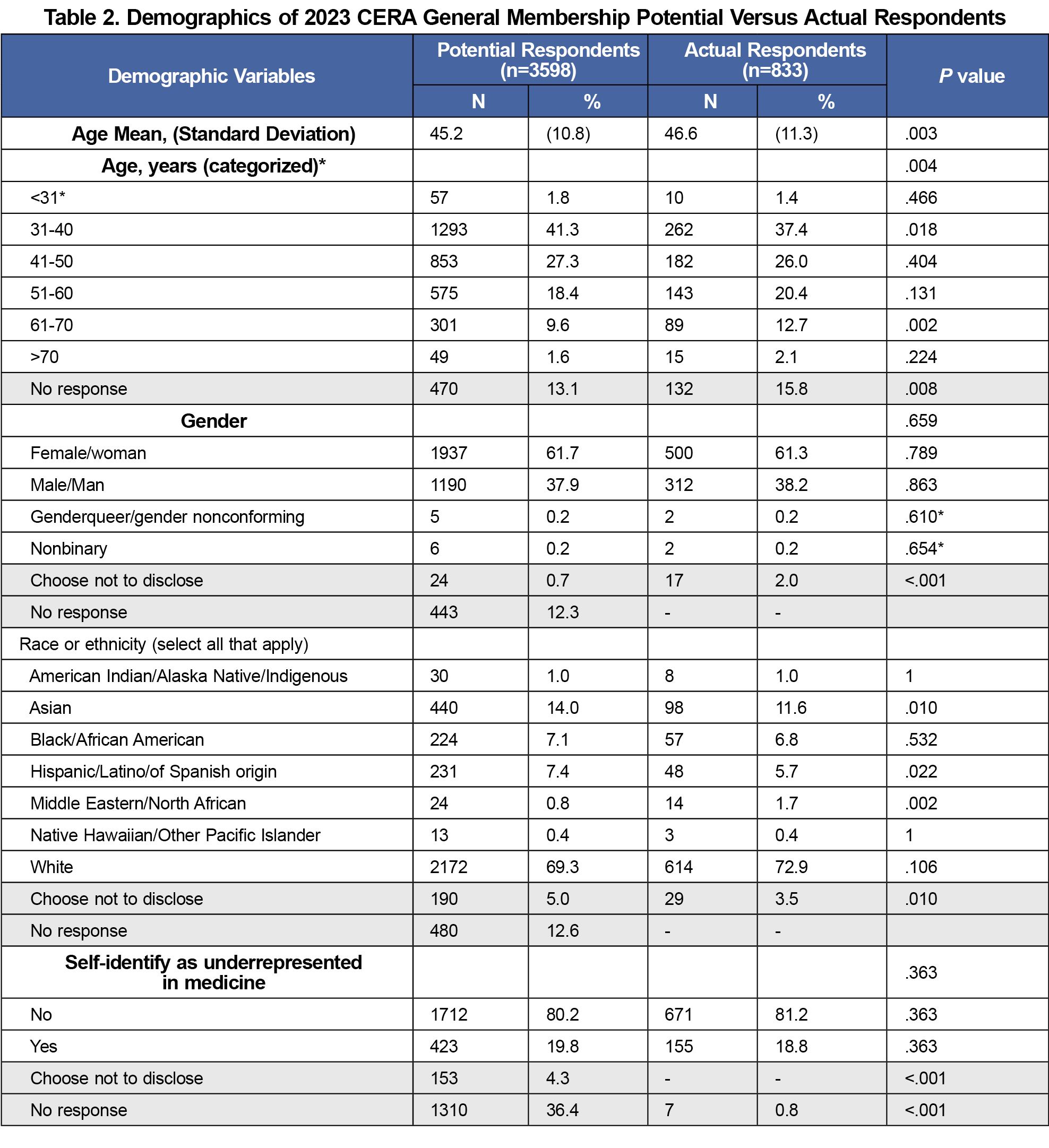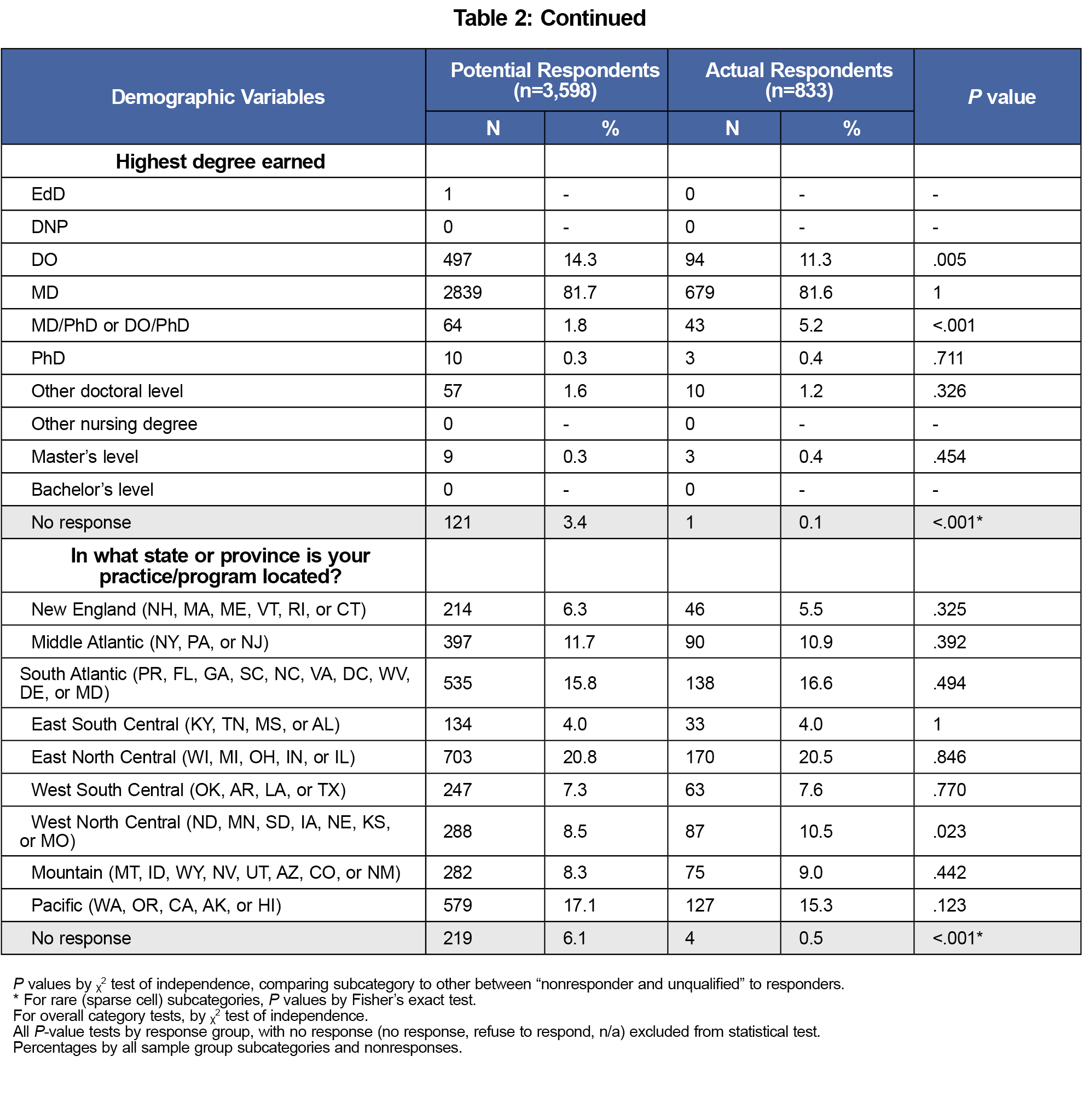Introduction: CERA, the Council of Academic Family Medicine (CAFM) Educational Research Alliance, represents a unique collaboration between family medicine organizations, conducting annual surveys of distinct groups within family medicine. CERA’s mission is to support family medicine educational research. This paper presents the methods and demographic results of the 2023 General Membership Survey.
Methods: CERA’s call for proposals for the annual General Membership Survey opened from June 2023 to July 2023. We received 16 proposals, and after a peer review process, five topics were accepted. Each author was assigned a research mentor. Because all the accepted proposals targeted physicians, the survey was distributed to select members of the CAFM organizations via SurveyMonkey from November 20, 2023 through December 22, 2023. We used χ2 and Fisher’s exact tests for analysis.
Results: The final pool size was 3,598. Eight-hundred thirty-three members completed the survey, for a response rate of 23.2% (833/3,598). Demographic data of potential survey respondents were compared with data of actual respondents. There were no significant differences in gender, location and underrepresented in medicine status. Actual survey respondents were slightly older, less likely Asian, and more likely to have a doctor of medicine (MD) or combined doctorate degree compared to potential survey respondents.
Conclusion: This paper describes the methods of the 2023 CERA General Membership Survey. The 2023 survey focused on active physicians. The demographics of the survey respondents differed slightly from potential respondents. Authors of the five accepted survey topics are responsible for publishing their study findings.
CERA stands for Council of Academic Family Medicine (CAFM) Educational Research Alliance. Founded in 2011, CERA’s mission is to provide a centralized infrastructure to foster medical education research and facilitate collaboration within family medicine.1 CERA consists of several family medicine organizations: the Association of Departments of Family Medicine (ADFM), Association of Family Medicine Residency Directors (AFMRD), North American Primary Care Research Group (NAPCRG), and Society of Teachers of Family Medicine (STFM).2
CERA produces rigorous and generalizable family medicine education research by conducting regular surveys of various family medicine groups regarding topics pertaining to medical education and research including clinical care, public policy, and curriculum development.3,4 Throughout the survey development and data analysis process, CERA provides training and mentorship in educational research methods to researchers.4,5
CERA conducts approximately five surveys each year. Each survey targets a specific audience such as family medicine department chairs, clerkship directors, residency program directors, and the general membership.
The General Membership (GM) Survey is disseminated annually to members of the CERA coalition. General members include, but are not limited to, family physicians, pharmacists, behavioral health/social science specialists, coordinators, administrator/mangers, and researchers. Each CERA survey includes questions submitted by investigators, and a set of recurring demographic and organizational questions.3 In this paper we present the methods and demographic results of the 2023 General Membership Survey.
The call for proposals for survey questions opened from June 19, 2023 to July 18, 2023. This year’s call encouraged topics focused on equity, diversity, and inclusion. We received 16 proposals, 5 of which were accepted after a peer-review process. Topics accepted in the 2023 GM Survey are listed in Table 1. Each author was assigned a mentor who aided in survey question revision. The GM Survey Director and CERA research fellow provided further feedback to review each proposal’s questions. Final edits were reviewed by the survey director, authors of each proposal, and a small team that piloted the survey questions. The survey was reviewed by a third party for readability and understandability. The study was approved by the American Academy of Family Physicians Institutional Review Board in November 2023.
Sample
Survey participants were pooled from the organizations that make up CAFM and located within the United States. Based on the accepted proposals’ intended audience, this year’s survey focused on physicians (doctor of medicine [MD]; doctor of osteopathic medicine [DO]; or bachelor of medicine, bachelor of surgery [MBBS or MBChB]). Participants were selected based on membership type and credentials, with the goal of selecting only active physicians. The pool excluded program directors, clerkship directors, and department chairs, medical students and residents. Among the CAFM organizations surveyed, 89.7% of participants were members of STFM, 5.8% from NAPCRG, 4.3% from AFMRD and 0.8% from ADFM. If a person held multiple memberships, their primary membership was listed as STFM.
Invitations to participate in the study was conducted through the online program SurveyMonkey. Nonrespondents received four weekly reminders and one final reminder to complete the survey. The survey was conducted between November 20, 2023, and December 22, 2023.
Analysis
Descriptive statistics were calculated including frequency and percentage. P values were calculated to compare potential versus actual survey respondents. Overall category- and subcategory-specific tests were calculated by χ2 test of independence or Fisher’s exact test, as applicable. Significance level was set to .05. All statistical tests were 2-sided. All analyses conducted in RStudio software.
The survey was distributed to 3,879 candidates. Of these, 155 were returned as undeliverable email addresses; 49 who had previously opted out of SurveyMonkey were also excluded. The prescreen asked if the individual had an MD, DO, or MBBS/MBChB degree. Seventy-seven candidates were nonphysicians, leaving a sample pool of 3,598.
Nine-hundred seventy-two people responded to the survey; 139 were excluded: 77 were nonphysicians and 62 only answered the prescreener. The survey received 833 responses for a response rate of 23.2% (833/3,598).
Demographics of the sample pool are based on membership data from ADFM, NAPCRG and STFM. Table 2 summarizes the demographic comparison between potential sample respondents and actual respondents. There was no significant difference between gender, self-identify as underrepresented in medicine, or location between responder groups. Compared to potential survey respondents, actual survey respondents were older (mean age: 45.2 years vs 46.6 years, P=.003; 9.6% vs 12.7% age 61-70 years old), and had a lower percentage of people who identify as Asian (14.0% vs 11.6%). There were fewer respondents with a DO degree (11.3% vs 14.3%) and a higher percentage of those with a combined degree (MD/PhD or DO/PhD (5.2% vs 1.8%) compared to the potential survey responders.
Table 3 summarizes additional demographic data asked in the CERA survey.
CERA’s primary vision is to support excellence in family medicine educational research with a secondary aim of improving research skills in family medicine. The CERA GM survey is conducted annually, and topics surveyed are based on member-submitted proposals. This allows CERA members to investigate topics that are timely, relevant, and pertinent to the field of family medicine education and research.
A strength of the CERA survey is its ability to target a national audience in a structured format. A strength of the GM Survey is that it can target members of all backgrounds or focus on subgroups. For example, the 2017 GM Survey surveyed nonphysician faculty.6 For 2023, the focus was on active physicians.
A limitation of the CERA survey is that each proposal is limited to 10 close-ended questions, which restricts the type of questions that can be asked. The response rate of 23.2% is in line with prior years of 20.1% (2020) to 25.0% (2022), but lower than prepandemic 52.7% (2017). Decreasing survey responses rates have occurred nationally since the pandemic.6 Furthermore, the demographics calculated are also limited due to the number of no responses and/or choose not to disclose. Unknown missing data type limits our ability to conclude that this survey sample is representative of the general membership and may influence generalizability of survey results.
Survey authors have exclusive access to their data for 90 days. After that, the data becomes accessible to all CERA members.5
Acknowledgments
The authors acknowledge the CERA Steering Committee for their help developing the manuscript version of this article.
References
- Significant Events in STFM History. Society of Teachers of Family Medicine. Accessed February 5, 2024. https://www.stfm.org/about/about/history/
- Seehusen DA, Mainous AG III, Chessman AW. Creating a centralized infrastructure to facilitate medical education research. Ann Fam Med. 2018;16(3):257-260. doi:10.1370/afm.2228
- Past Survey Data by Topic. Society of Teachers of Family Medicine. Accessed February 5, 2024. https://www.stfm.org/publicationsresearch/cera/pasttopicsanddata/pasttopiclist/
- Shokar N, Bergus G, Bazemore A, et al. Calling all scholars to the Council of Academic Family Medicine Educational Research Alliance (CERA). Ann Fam Med. 2011;9(4):372-373. doi:10.1370/afm.1283
- CERA Now Seeking Applications to Serve as a Mentor and Survey Reviewer. STFM News. Accessed February 5, 2024. https://stfm.org/news/2022news/1-1-23-call-for-applications-cera-survey-mentor-and-reviewers/
- Mainous AG III, Rahmanian KP, Ledford CJW, Carek PJ. Professional identity, job satisfaction, and commitment of nonphysician faculty in academic family medicine. Fam Med. 2018;50(10):739-745. doi:10.22454/FamMed.2018.273724
- Krieger N, LeBlanc M, Waterman PD, Reisner SL, Testa C, Chen JT. Decreasing survey response rates in the time of covid-19: implications for analyses of population health and health inequities. Am J Public Health. 2023;113(6):667-670. doi:10.2105/AJPH.2023.307267







There are no comments for this article.